From Rocks to Recliners – The History of Upholstery
By Shelagh Duncan
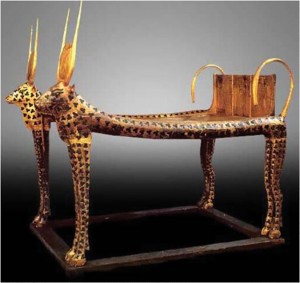
One of the things we learn early on in CR is that Tico chairs and sofas leave a lot to be desired in the comfort department. The mattress, chair and sofa are the most important pieces in your home. They are where you will spend most of your time typically, and so they need to provide good quality and comfort. But a comfortable, upholstered piece of furniture wasn’t always an option.
When did we humans stop sitting around in the dirt or on a convenient rock and start wanting the comfort of something better? Well, nothing happened fast in the history of mankind but about the time Stonehenge was being erected and we were just beginning to work with bronze, the people of ancient Egypt were already enjoying their leisure time with semi-comfortable furniture. If you had the prestige, power and ‘purse’ to allow some leisure, then there were animal hair-stuffed cushions, fine fabrics draped across daybeds and gilded and decorated chairs to offer relaxation.

The Egyptians led the world in furniture making during that time. We have well preserved examples of furniture that was discovered in some of the ancient tombs, as well as pictorial records from their wall paintings, art and pottery.
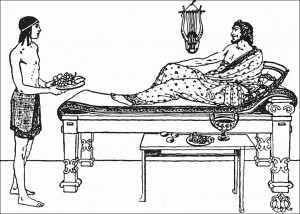
There were basically two categories of furniture early on – things to sit or lie on, and boxes or chests for storage. They were cleverly constructed. In order to be portable, larger items were made as easy-to-assemble pieces – no moving trucks in those days!
The furniture styles from these times were adopted and adapted by later cultures and are actually are still inspiring furniture design today. When Egypt was eventually conquered by Alexander the Great, and later by the Romans, both the Greek and Roman conquerors were significantly influenced by Egyptian culture, art and philosophy, so that to some extent it was actually a case of the conquerors being civilized by the conquered.
Furniture was still a bit of a status symbol and each culture used their own unique decorative details for embellishment. The variety of furniture pieces increased as living standards rose and comfort and convenience became a bit more accessible, although only the rich had the luxury and ‘comforts’ of home.
You ‘La-z-boy’ guys may enjoy the fact that the original reclining chair was actually a couch – a place of honour for the most important people to eat, be entertained, or for conversation. Everyone else stood.
However, with the collapse of the Roman Empire during the 4th–5th centuries, Europe sank into a period in which little furniture, except the most basic, was used: stools, benches, beds and primitive chests were the most common items.
Several centuries were to pass before this was to change. In 1465, the Worshipful Company of Upholders of the City of London was granted its Coat of Arms and its Royal Charter a couple of hundred years later. This was the beginning of any formally recognised upholstery industry. They joined the many other craft guilds that were offering apprenticeships in those times and they regulated, promoted and took pride the high quality of workmanship they produced.
In the 14th & 15th centuries there were new developments in furniture building, but even into the 16th and 17th centuries, all types of furniture remained pretty scarce. The best furniture belonged to nobility and wealthy merchants, and of course for the higher ranking clergy and church.
During the Renaissance there were significant changes that expanded found their way all across Europe. The growth of a wealthy and powerful bourgeoisie caused the building of more substantial houses and a demand for better quality furniture. Leather chair seats had been in use for some time, but now they were starting to be upholstered with tapestry and other fabric, and bed frames were strung with ropes to support mattresses and offered a little comfort. Italy established itself as a center for fine textiles, and upholstery skills began to spread throughout Europe.
The chair was an opportunity where upholsterers firmly ensconced themselves in furniture-making, becoming a legitimate (although, still expensive) industry. Previously, upholsterers would primarily focus on beds – padded headboards and all-around draperies to stop the drafts.
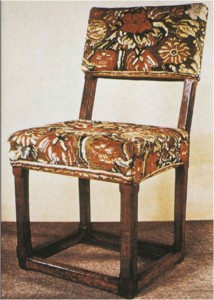
It was during the reign of Elizabeth I that the Farthingale chair (or back stool), was created. It was made without arms to accommodate the large skirts of the time, and its small, square back and seat were stuffed and covered with leather or tapestry stretched across and trimmed with nail-heads—permanent upholstery for the first time!
We must remember that to us, chairs are a natural part of any room, but back then chairs were few and far between. They were looked on as a seat of honour, and even in large halls there was only one chair and that was reserved for the most important person. Even the most lavishly decorated thrones were not concerned with comfort, just grandeur.
Upholsterers quickly became more involved in creating chairs with permanent coverings, although simple, loose seat cushions were still predominant. The Farthingale chair was designed for the ladies of the Court so they could sit gracefully with their big petticoats, and it came to be known as “an upholsterers’ chair”— but comfort as we know it today was still a long way off.
Upholstered chairs were the first generation of stuffed chairs but they were definitely not considered masculine. They remained blocky looking and uncomfortable probably because they were still being produced by carpenters and wood workers.
The first fully upholstered chair finally arrived in 1705. Beautiful fabrics including silks and elaborate tapestries were now being produced as well as decorative trimmings; finally beauty and comfort were starting to come together.
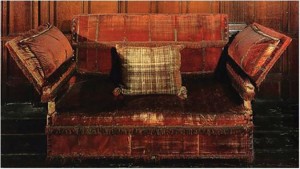
Other new forms of furniture also began to develop around that time – the daybed, a form of couch with an adjustable end, the winged armchairs, the upholstered armchair and a little later toward the end of the century, the Knole settee. This settee was ordered for one of the great historic English houses, and became an important prototype for the modern sofa. It had a back and adjustable arms and carried comfort a step further. Velvet, silks, and needlework were common materials for upholstery.
Previously, seat furniture for more than one person was generally confined to benches, which would be pushed against the wall for back support and protection from cold.
The high standards of workmanship and versatility in the craft grew rapidly in order to keep up with the ever increasing demand, reaching its peak during the Victorian and Edwardian eras.
The Industrial Revolution brought about an unprecedented volume and variety of factory-produced goods and raised the standard of living for many people, particularly for the middle and upper classes. We may look at Victorian living rooms now and think them too busy and crowded, but it was highly desirable to have a home laden with furniture to as a measure of status. Upholstery had come into its own. Machines could produce furniture faster and much cheaper than ever before.
Unfortunately, too much of a good thing isn’t always good, and that was what drove William Morris, father of the Modern Movement, to turn away from shoddily machine-made, mass produced furniture in the mid 1800’s and focus on a return to the skills of a craftsman’s hand. Morris could not stop the explosive progress of the machine age, but led a movement to re-inspire the aesthetic sense of his contemporaries and bring back quality and beauty.
“Have nothing in your houses that you do not know to be useful, or believe to be beautiful” – my favourite Morris quote!
After the wars, furniture design was bursting with creativity. Design schools emerged promoting new ideas and directions, offering a world of choices. The old ways were challenged and inspirations were drawn from many different places.
Modern furniture focused on the linear look and minimalist aesthetic -seating was firm to keep that look consistent. New materials like plastics, plywood and tubular metal were being developed that offered new design styles and options for furniture.
In the 1950’s, ergonomics* was starting to be used to help the way we work and interact with machines in factories. Once it entered the office domain with desks and chairs, the concept spread and naturally domestic furniture benefitted greatly. Furniture was being designed for the comfort of the human body by reducing fatigue by offering ‘fit’ and support. Talking about the new designers’ approach to ergonomics it was said “Eames, in particular, worked through a very iterative process and sought to create unmatched comfort – an outcome of good ergonomics – while exploring new materials and forms.”
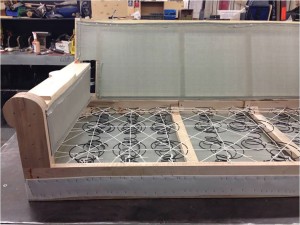
Traditional upholstery was hugely labour intensive and uses springs, lashings, stuffings of animal hair, grasses and coir, wools, hessians, scrims, bridle ties, stuffing ties, blind stitching, top stitching, flocks and wadding etc. building up each layer by hand.
In contrast, modern upholsterers typically employ synthetic materials like dacron and foam, serpentine springs, etc. However, the most expensive seating will have traditional 8-way hand-tied coil springs to give continued support. It will also use feather and down stuffing and many other specialty layers and additions. That is why these are the most expensive types of seating, but they will retain the same level of comfort for much longer.
Adding a slab of foam on top of a flat wooden seat is the other end of the spectrum. These are the pieces we are more likely to encounter in Costa Rica , and partially because of the quality of the foam and the climate, you will likely end up with donut-seat-syndrome after 2 or 3 years.
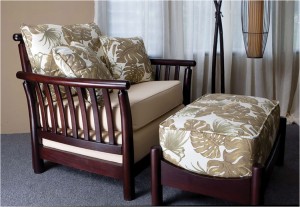
We expats have been very spoiled and have never had to think about the comfort of a chair or sofa when shopping back home. Did the style, the fabric and price match our expectations? SOLD! Unfortunately, it’s not as easy down here. We need to sit in a lot of chairs and do our research well before we make those important decisions. Investing in key pieces like a good mattress or chair will give you comfort and benefit your body, and you and your guests will appreciate them for years to come.
Until next time…
[email protected]
www.royalpalminteriors.com
* Ergonomics is the study of human abilities and characteristics which affect the design of equipment, systems, and jobs.
